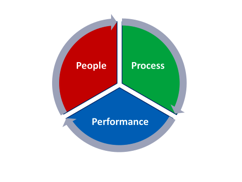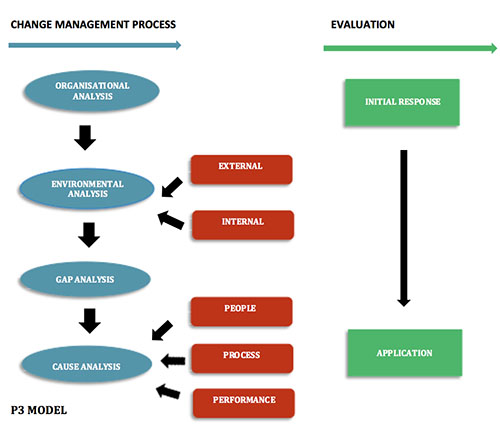Getting Started- An Introduction to P3
This toolkit provides a guide to the P3 methodology which was developed at Bangor in 2015/16with funding from the Leadership Foundation Innovation and Transformation Fund. It provides a systematic framework for change management projects. The methodology can be adapted to suit large and small scale projects and it can suit the aims and context of different types of project. This document is a guide and provides a pro forma to help the planning process of your project.
A key aim of P3 is to be clear about the expected outcomes of a project (performance) and that the objectives of the project are clearly defined and explored to ensure the best outcome for the project. P3 also separates the analysis into people and process. These of course overlap and are inter-related. However by separating both it is potentially easier to analyse and identify the critical barriers to success.
The overall aim of P3 is to link all these elements to ensure project success. The key questions therefore to consider when using P3 are:
- What do you need to achieve and why?
- In terms of the ‘big picture’, what are the key drivers of the change?
- How does the current state or situation relate to the required change?
- What does the gap between where you want to be and where you are look like?
- What are the causes of those gaps in terms of people, performance and process?
- What action must be undertaken to address those gaps in order to achieve the overall aim?

In terms of P3, when talking about performance, people and process the following illustrate what elements of the project are analysed under the various elements:
Performance: |
Analysing and defining the level of performance required at completion of the project. |
People: |
Examining the elements of the project that are people related such as; levels of skills and knowledge, capacity, leadership, job roles, motivation, performance management, organisational culture, team working and the ergonomics of the workplace etc. |
Process: |
Examining the elements of the project that are process related such as; internal processes to the team, University processes that impact on the project, Finance systems and IT systems etc. |
Another element of P3 is to review progress and impact throughout the project and after its completion. During the project the evaluation process can be used to ensure that staff understand the aims of the project and have ‘buy-in’ to the project. At the end of the project the evaluation process aims to demonstrate the project’s impact, level of success and addresses aspects of the project that may not be working effectively.
Using the Toolkit
The aim of the Toolkit is to provide you with a framework and guide for each section which you can use and adapt to suit your needs and the project. Each section also poses some questions to get you thinking about the information you may need. Some sections also provide guidance regarding the methodologies that may help you collect and analyse the information you need. These lists are not exhaustive.
Some Suggestions
- There is a Powerpoint presentation that you can use to run a short workshop to take you through the methodology. This works best when it’s as practical as possible so you could use this as the start-up meeting for the project with your team. The best starting point is your institutional change management specialist and we are happy to help too – please see the contact details on the web site.
- JISC have useful guides to change management that you may find useful for more information. You may find this useful, particularly in helping you select different tools that can help you analyse your current situation.
- Go to the ‘Lessons Learnt’ section on the web page so that you can learn from others’ experiences.
P3 MODEL

